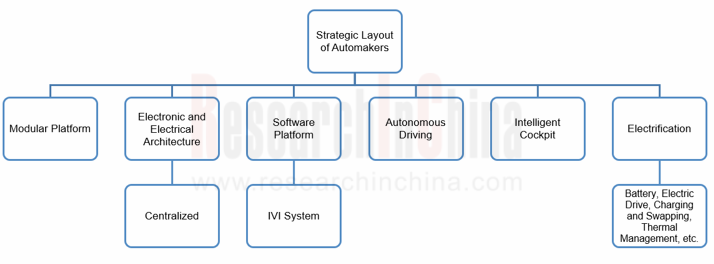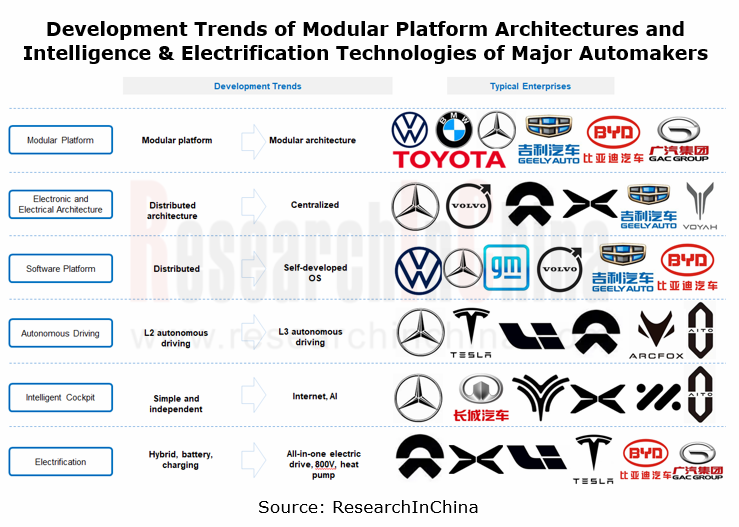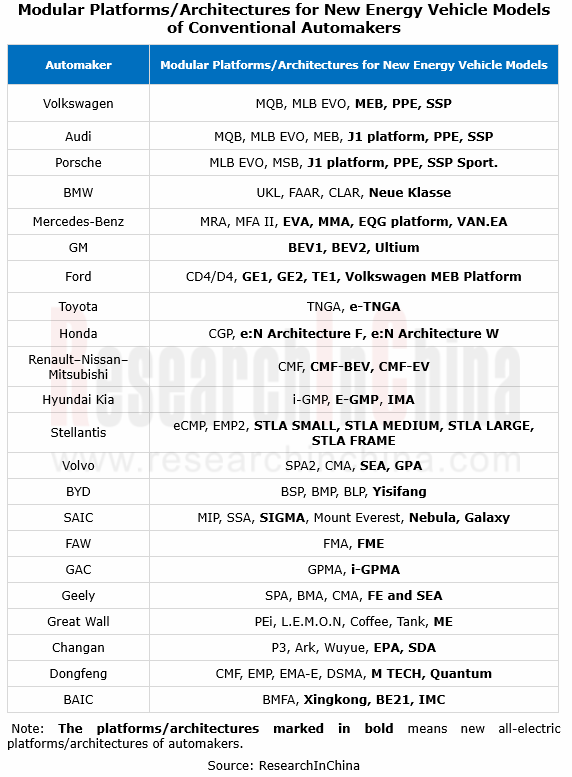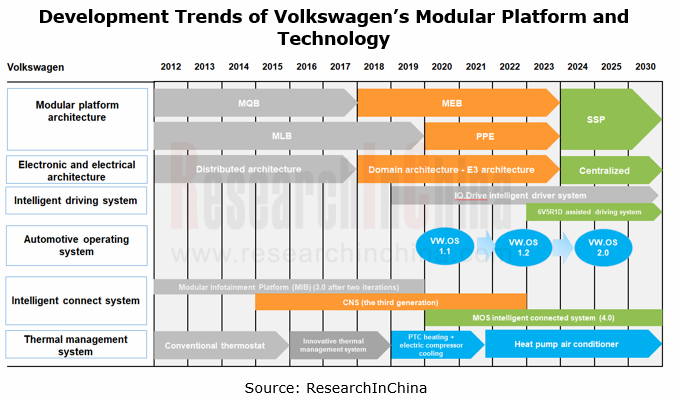Global and Chinese Automakers’ Modular Platform and Technology Planning Research Report, 2023
Research on modular platforms: explore intelligent evolution strategy of automakers after modular platforms become widespread.
By analyzing the planning of international automakers, Chinese conventional automakers and emerging car brands for modular platform architectures, autonomous driving and other technologies, the report explores the significance and role of modular platform architectures in new energy vehicles in today’s electrification and intelligence development.

The path of new energy vehicle development is gradually clear: modular architecture + intelligence.
For a model or a range of models, there are two most important automotive architectures: chassis & body architecture, and electronic and electrical architecture. The chassis + electronic architecture platform provides a further guarantee for the scale, development speed and reliability of new energy vehicles. With vehicle intelligence, the software platform, autonomous driving, intelligent cockpit and electrification of vehicles have become important indicators affecting vehicle performance.

The exclusive all-electric platform architecture has become the foundation for R&D of vehicle models.
In the R&D process of new energy vehicles, there are two different technology paths: new energy vehicles (PHEV+EV) are refitted on conventional fuel-powered vehicles, also known as “fuel to electricity”, and most still have fuel-powered models; products are built on brand-new exclusive all-electric platforms/architectures.
In the early development of new energy vehicles, most conventional automakers developed new energy vehicles by way of “fuel to electricity”. Yet as new energy vehicles boom, such new energy models are not enough to meet the development needs for more intelligent, more optimized, more integrated and higher performance new energy vehicles. The all-electric platform technology has matured. To adapt to the development trend for electrification, conventional automakers have launched exclusive all-electric modular platforms/architectures, and will develop more in the future.

For example, from 2019 to 2030, Volkswagen will make intensive efforts on modular platform architectures, E/E architectures, intelligent driving systems, software platforms, intelligent cockpits and electrification platforms: from 2024 onwards, the Scalable Systems Platform (SSP) will replace MEB and PPE as the main architecture of new battery-electric vehicle models; the centralized E/E architecture will substitute the domain architecture as a standard part of the SSP; in the field of autonomous driving and intelligent cockpit, VW.OS2.0 will become the mainstream software platform; the IVI system MOS 4.0 based on Samsung Exynos Auto V9 will become the mainstream cockpit system.

City NOA system is produced and applied on a large scale.
China's upcoming L3 autonomous driving standard will favor the fast commercial application of autonomous driving. From the perspective of the autonomous driving systems of new energy vehicles, the commercial use of city NOA systems has become the key to L2+ ~ L3 autonomous driving systems.
As Xpeng, Li Auto and Avatr among others announced the layout of city NOA (navigate on autopilot), the system that offers point-to-point intelligent driving assistance goes into mass production and wide adoption in 2023.
Intelligent Driving 3.0 of Li Auto has enabled city NOA from highway NOA, and notified beta users in the second quarter of 2023. It will spread to 100 cities of China in late 2023.
Cockpit AI Agent Research Report, 2024
Cockpit AI Agent: Autonomous scenario creation becomes the first step to personalize cockpits
In AI Foundation Models’ Impacts on Vehicle Intelligent Design and Development Research Report, 2024, Res...
Leading Chinese Intelligent Cockpit Tier 1 Supplier Research Report, 2024
Cockpit Tier1 Research: Comprehensively build a cockpit product matrix centered on users' hearing, speaking, seeing, writing and feeling.
ResearchInChina released Leading Chinese Intelligent Cockpit ...
Global and China Automotive Wireless Communication Module Market Report, 2024
Communication module and 5G research: 5G module installation rate reaches new high, 5G-A promotes vehicle application acceleration
5G automotive communication market has exploded, and 5G FWA is evolv...
ADAS and Autonomous Driving Tier 1 Suppliers Research Report, 2024 – Chinese Companies
ADAS Tier1s Research: Suppliers enter intense competition while exploring new businesses such as robotics
In China's intelligent driving market, L2 era is dominated by foreign suppliers. Entering era...
Automotive Gateway Industry Report, 2024
Automotive gateway research: 10BASE-T1S and CAN-XL will bring more flexible gateway deployment solutions
ResearchInChina released "Automotive Gateway Industry Report, 2024", analyzing and researching...
Global and China Electronic Rearview Mirror Industry Report, 2024
Research on electronic rearview mirrors: electronic internal rearview mirrors are growing rapidly, and electronic external rearview mirrors are facing growing pains
ResearchInChina released "Global a...
Next-generation Zonal Communication Network Topology and Chip Industry Research Report, 2024
The in-vehicle communication architecture plays a connecting role in automotive E/E architecture. With the evolution of automotive E/E architecture, in-vehicle communication technology is also develop...
Autonomous Delivery Industry Research Report, 2024
Autonomous Delivery Research: Foundation Models Promote the Normal Application of Autonomous Delivery in Multiple Scenarios
Autonomous Delivery Industry Research Report, 2024 released by ResearchInCh...
Global Autonomous Driving Policies & Regulations and Automotive Market Access Research Report, 2024
Intelligent driving regulations and vehicles going overseas: research on regional markets around the world and access strategies. "Going out”: discussion about regional markets aroun...
China Passenger Car HUD Industry Report, 2024
HUD research: AR-HUD accounted for 21.1%; LBS and optical waveguide solutions are about to be mass-produced. The automotive head-up display system (HUD) uses the principle of optics to display s...
Ecological Domain and Automotive Hardware Expansion Research Report, 2024
Automotive Ecological Domain Research: How Will OEM Ecology and Peripheral Hardware Develop? Ecological Domain and Automotive Hardware Expansion Research Report, 2024 released by ResearchInChina ...
C-V2X and CVIS Industry Research Report, 2024
C-V2X and CVIS Research: In 2023, the OEM scale will exceed 270,000 units, and large-scale verification will start.The pilot application of "vehicle-road-cloud integration” commenced, and C-V2X entere...
Automotive Intelligent Cockpit Platform Configuration Strategy and Industry Research Report, 2024
According to the evolution trends and functions, the cockpit platform has gradually evolved into technical paths such as cockpit-only, cockpit integrated with other domains, cockpit-parking integratio...
Analysis on Huawei's Electrification, Connectivity, Intelligence and Sharing,2023-2024
Analysis on Huawei's Electrification, Connectivity, Intelligence and Sharing: Comprehensive layout in eight major fields and upgrade of Huawei Smart Selection
The “Huawei Intelligent Driving Business...
Li Auto’s Layout in Electrification, Connectivity, Intelligence and Sharing and Strategy Analysis Report, 2023-2024
Li Auto overestimates the BEV market trend and returns to intensive cultivation.
In the MPV market, Denza D9 DM-i with the highest sales (8,030 units) in January 2024 is a hybrid electric vehicle (H...
Analysis on NIO’s Layout in Electrification, Connectivity, Intelligence and Sharing, 2023
Analysis on NIO’s Layout in Electrification, Connectivity, Intelligence and Sharing, 2023
Because of burning money and suffering a huge loss, many people thought NIO would soon go out of business. NI...
Monthly Monitoring Report on China Automotive Sensor Technology and Data Trends (Issue 3, 2024)
Insight into intelligent driving sensors: “Chip-based” reduces costs, and the pace of installing 3-LiDAR solutions in cars quickens. LiDARs were installed in 173,000 passenger cars in China in Q1 2024...
Autonomous Driving Simulation Industry Report, 2024
Autonomous Driving Simulation Research: Three Trends of Simulation Favoring the Implementation of High-level Intelligent Driving.
On November 17, 2023, the Ministry of Industry and Information Techno...